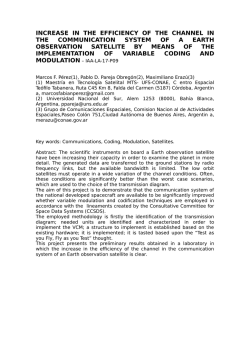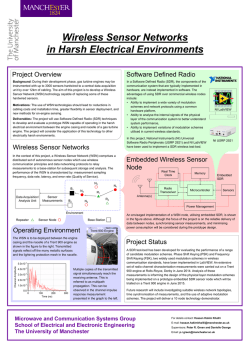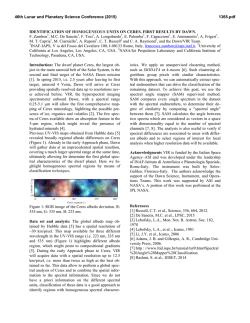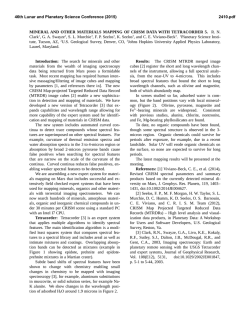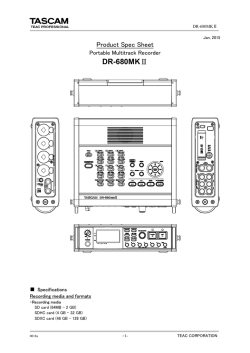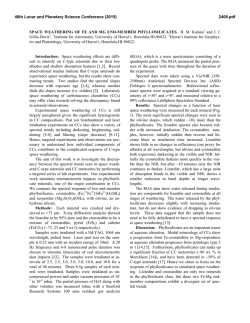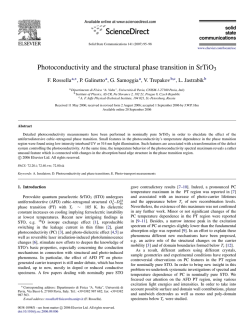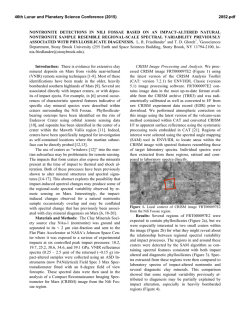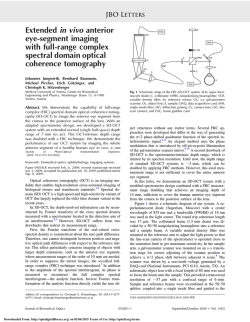
Canadian Licensed Pharmacy - LTD. Chemistry Behind Viagra
Copyright (c) 1997 Institute of Electrical and Electronics Engineers. Reprinted, with permission, from MILCOM 1997. This material is posted here with permission of the IEEE. Internal or personal use of this material is permitted. However, permission to reprint/republish this material for advertising or promotional purposes or for creating new collective works for resale or redistribution must be obtained from the IEEE by sending a blank email message to [email protected]. By choosing to view this document, you agree to all provisions of the copyright laws protecting it. HIGH DATA RATE UHF SATCOM Donald R. Stephens, Member, IEEE Kevin C. Kreitzer, Member, IEEE Raytheon E-Systems St. Petersburg, Florida though the uplink signal may be spectrally contained, the hard limiters in the UHF SATCOM satellite cause a regeneration of the previously filtered spectrum. The result is significant out-of-band spectral energy. ABSTRACT Users of UHF SATCOM require higher data rates to support today’s sophisticated C4I mission planning and execution methods that are associated with the Digital Battlefield of the war fighter. Unfortunately, the UHF SATCOM channel has characteristics which prevent the implementation of advanced modulation techniques developed in the commercial industry. As an example, the QAM modulation format of cable modems cannot be transmitted through the limiters in the UHF satellites because it does not have a constant waveform envelope. For optimum UHF satellite transponder performance, the modulation must have a constant envelope. This paper discusses modulation formats that have a constant envelope and a Bits/Hertz performance much closer to Shannon's limit than the current waveforms on UHF SATCOM. A set of waveforms is presented which is compatible with the UHF SATCOM specifications and provides the desired data rate improvement without requiring additional bandwidth. These waveforms allow a doubling of the current data rates without requiring additional bandwidth. In many applications these increased data rates are available without increased transmitter power. The hard-limiting UHF SATCOM channel also removes amplitude modulation on the uplink signal. This permits the use of efficient Class C amplifiers for the uplink terminals, but eliminates compact modulation waveforms such as Quadrature Amplitude Modulation (QAM). These two characteristics of the UHF SATCOM channel, spectral regrowth and AM suppression, form an implicit requirement for the modulation waveform -- a constant envelope. Consider the degrees of freedom available in designing a modulation waveform for UHF SATCOM. For a generic waveform s (t ) = a(t )e j φ ( t) (1) hard-limiting requires that a(t ) = constant (2) and in order to prevent spectral regrowth d n φ( t ) dtn INTRODUCTION Given the historical use of Binary and Quadrature Phase Shift Keying (PSK), an obvious method of increasing data throughput on UHF SATCOM would be increasing the modulator's alphabet, up to 8 or 16-PSK. However, a previous government program to increase the data throughput of UHF SATCOM encountered spectral regrowth when attempting to filter 16-PSK [1]. Even (3) must exist for n≥1. Figure 1 shows some of the modulation waveforms that are available for SATCOM. Also shown is the ShannonHartley capacity limit [2], 1 S C = BRF log 2 ℜℜ 1 + ℜℜ N , THE HIGH DATA RATE UHF SATCOM WAVEFORM (4) Raytheon E-Systems has developed a CPM modulation scheme as our candidate for the next-generation high data rate UHF SATCOM waveform. The generalized CPM waveform is expressed mathematically as where C is the capacity of the channel, BRF is the channel bandwidth, S/N is the signal-to-noise ratio. The CPM spectral efficiency is provided relative to the 5 kHz and 25 kHz UHF SATCOM channels. For example, the 4800 bps CPM waveform fits inside the 5 kHz channel, so we assign a 0.96 bits/Hz efficiency. The 14400 bps also fits within the 5 kHz channel, so we assign a 2.88 bits/Hz spectral efficiency for this waveform. (Recall QPSK requires 8.2 x bit rate for 99% power within band.) s (t; α=) = ϕ (t; α=) = 2π .. Spectral Efficiency ç Bits ÷ Hertz 4 16PSK ∞ -∞ i= -∞ h i ai g(τ − iTs )dτ . (6) Ts is the symbol period TCM 16PSK TCM 8PSK 2 α= = (,a −2 , a −1 ,a 0 , a1 ,a 2 ) is a specific data sequence h i {i = 1, 2,, K } is a set of phase modulation indicies which is repeated 8PSK g}(t) is a frequency pulse - shape function which determines the waveform shaping High Speed SATCOM Waveform (CPM) * For the frequency pulse g(t) in (6), we have selected a rectangular pulse. In the phase domain, this corresponds to a linear phase ramp. Referred to as LREC, it is defined as QPSK MSK FEC QPSK FEC BPSK BPSK 1 0 ≤ t ≤ LT g(t ) = 2 L T 0 otherwise . * Bits/Hertz Relative to Required Channel Bandwidth 0 t Es is the symbol energy 3 1 (5) where 5 Shannon's Capacity Limit 2Es Cos[2π f 0 t + ϕ (t; α=) + ϕ 0 ] Ts 10 C −5 for 10 BER N 20 30 Figure 1. Spectral Efficiencies of Various Modulations (7) Equation (7) indicates that the frequency pulse could extend over more than one symbol. This is known as partial response CPM. Although this deliberate intersymbol interference can increase signal-to-noise performance, we selected L=1 which is known as full response CPM. This means that the phase-change period is equal to the symbol period. Full response provides more robust synchronization. Of all the waveforms shown in Figure 1, only two are strictly constant envelope. These are Minimum Shift Keying (MSK) and Continuous Phase Modulation (CPM). Others such as QPSK, trellis coding of 8-PSK and 16-PSK, all have amplitude variations. Continuous Phase Modulation (MSK is a special case of CPM) has smooth phase transitions so that non-linear band-limited channels are acceptable. To increase spectral efficiency, we have chosen quaternary CPM instead of binary CPM. This indicates a mapping of two data bits per symbol. In other words, the ai in (6) become ai = {-3, -1, +1, +3} (8) Finally, we have combined modulation and coding by using a multi-h CPM waveform. This means that the modulation indices will vary on a symbol-by-symbol basis. Figure 2 shows an example phase trellis of a quaternary multi-h, CPM waveform. In the first interval, the phase will change by either ±4π/16 or ±12π/16, depending on the input symbol pair. A phase change of +4π/16 is shown in the example. The next symbol has a phase change of ±5π/16 or ±15π/16, again depending upon the input symbol pair. The third transmitted symbol will 2 waveform. The particular trellis codes and frequency pulses were selected for reasonable levels of modem complexity. The waveforms can all be implemented in software for real-time operation with current technology. again have a phase change of ±4π/16 or ±12π/16, as the modulation indices are periodic. H1 = 4š/16 H2 = 5š/16 0 4š/16 +3 8š/16 -3 -3 Waveform Characteristic Tradeoff Comments CPM Constant Envelope • required for UHF SATCOM operation Rectangular Frequency Pulse Far-out Spectral Energy • better close-in suppression of sidelobes • software-only change to existing modulators -1 12š/16 Quaternary +1 16š/16 Spectral Containment -1 • best match with required data rates +3 Full Response 20š/16 • reduced processing costs over 8-ary +1 Spectral Containment • reduced processing costs over partial response • better synchronization performance than partial response 24š/16 Figure 3. Characteristics and Tradeoffs of the High Speed Waveform. 28š/16 Figures 4 and 5 present the trellis codes used for the different bit rates on both the 25 kHz and 5 kHz UHF SATCOM channels. The modulation indices for the quaternary multi-h CPM waveforms are given, as well as the C/kT required for 10-5 BER performance. Implicit in the specifications is a 2 dB receiver implementation loss and a 2 dB spurious degradation from theoretical. In Figures 4 and 5 we abbreviate hi = {3π/16, 4π/16} as h16{3, 4}. Figure 2. Quaternary Multi-h CPM Phase Trellis Example The trellis determines both the spectrum and the Eb/No performance of the CPM waveform. The spectrum is most affected by the size of the modulation indices and the spacing between them. The signal space distance between the different symbols for CPM is determined by the integrated phase difference between the two sequences. The constraint length of a trellis is how many symbols it takes for two different sequences to end at the same position in the trellis. The constraint length and modulation indices thus both determine the Eb/No performance of the CPM waveform. By using different values of h, we can tailor the spectral bandwidth and signal/noise performance. There are many different considerations and optimizations of the CPM waveform [3]. Figure 3 summarizes the characteristics of the High Data Rate UHF SATCOM 3 Spurious (dBc) Bit Rate h16={a,b} C/kT 5 kHz 10 kHz 14400 {3,4} 52.8 -16.0 -27.7 12000 {4,5} 50.0 -15.0 -30.5 9600 {4,5} 49.0 -18.0 -32.0 8000 {5,6} 47.5 -19.2 -34.0 7200 {6,7} 47.2 -21.0 -28.0 6000 {7,10} 46.0 -16.0 -32.0 4800 {12,13} 44.0 -18.9 -30.4 Figure 4. 5 kHz Waveform Specifications Figure 7. Measured Spectrum for 64 kbits/s, hi = {4π/16, 5π/16} Spurious (dBc) Bit Rate h16={a,b} C/kT 25 kHz 100 kHz 76800 {3,4} 60.1 -13.9 -41.6 64000 {4,5} 57.5 -14.0 -39.0 56000 {4,5} 57.0 -15.5 -43.0 48000 {4,5} 56.0 -18.0 -43.0 40000 {5,6} 55.0 -22.3 -47.0 32000 {6,7} 53.2 -25.0 -47.0 19200 {12,13} 50.0 -22.3 -47.3 The significance of CPM on UHF SATCOM is shown in Figure 8, where the projected CPM performance is contrasted with the current UHF waveforms. The link power is referenced to 9600 bits/s operation. As shown, with exactly the same carrier power, antenna, etc., the CPM waveform can support double the data rate. Other higher data rates can be provided without large increases in C/kT. Further, significant link margin improvements can be acheived by using CPM in place of PSK at the existing data rates -- e.g., 5 dB improvement at 19200 bits/s. 4 Figure 5. 25 kHz Waveform Specifications 2 0 Shown in Figure 6 is the analytic spectrum for a quaternary multi-h CPM waveform with modulation indices of hi = {4π/16, 5π/16}. The horizontal axis is normalized to symbol rates. For reference, an unfiltered QPSK spectrum is also shown. Figure 7 is a measured spectrum for the 64 kbits/s rate with modulation indices of hi = {4π/16, 5π/16}. -2 -4 -6 -8 -10 9600 PSK -2 -1 1 2 3 32000 40000 48000 56000 64000 76800 Bit Rate (Bits/Sec) IMPLEMENTATION 1 Ts Raytheon E-Systems has implemented the CPM waveforms as part of the Multiple Output SATCOM Transceiver (MOST). The MOST is a software-based radio using six processors. Three of these processors perform baseband I/O functions, one performs network and transport layer functions, one performs link layer functions, and one performs modulation and demodulation functions. The processor performing modulation and demodulation is referred to as the Modem Processor. A Modem Processor transmit block diagram is shown in Figure 9 and a receive block diagram is shown in Figure 10. -1 0 QP S K -2 0 -3 0 CPM 19200 Figure 8. Comparison of CPM and Existing UHF Waveforms dB 10 -3 CPM -4 0 Figure 6. Analytic Spectrum for hi = {4π/16, 5π/16} 4 preamble tables timer input routine mapping routine For non-coded modulations, the MLE matched filter correlates the incoming waveform against all possible incoming waveforms. It uses the correlation scores to decide which waveform was most likely received. For coded modulation schemes such as CPM, this is not sufficient since it does not take advantage of the inherent memory in the waveform. Instead, the correlation scores serve as path metrics for a Viterbi Decoder [4]. The output of the Viterbi Decoder also serves as the data decision algorithm. DDS Figure 9. MOST Modulator Block Diagram The Phase Detectors are constructed by taking the partial derivatives of the best survivor from the Viterbi Algorithm with respect to phase and time [5]. Modulation of the CPM waveform in the MOST architecture reduces to a simple table look-up. Because the waveform uses full response rectangular frequency pulse shaping, modulation requires generation of eight frequency steps corresponding to ±h1, ±3h1, ±h2, and ±3h2. The MOST Radio generates these frequency steps using Direct Digital Synthesis (DDS). Modulation, then, is simply a task of mapping the incoming symbol to the appropriate frequency control word for the DDS and sending it to the control latch at the proper time. Carrier Loop Filter Carrier NCO SUMMARY A set of waveforms is presented which is compatible with the UHF SATCOM specifications and provides desired data rate improvement without requiring additional bandwidth. Known as quaternary full response multi-h CPM, these waveforms allow a doubling of the current data rates without requiring additional bandwidth. In many applications these increased data rates are available without increased transmitter power. The waveforms are constant envelope to accommodate the hard-limiting UHF SATCOM channel. Finally, these waveforms have been successfully implemented in the Raytheon E-Systems MOST Radio. Carrier Phase Detector Lock Detector A/D Converter Data Detection MLE Timer Clock NCO Clock Loop Filter Clock Phase Detector Figure 10. MOST Demodulator Block Diagram Demodulating the CPM waveform, like all MOST demodulation waveforms, utilizes a Maximum Likelihood Estimation (MLE) architecture. MLE demodulation of CPM closely resembles traditional phase-locked loop demodulation with three notable exceptions -- the phase detector, the matched filter, and the data decision algorithm. 5 [1] QUALCOMM "High Data Rate Satellite Communications Study Final Technical Report," Prepared for Naval Oceans Systems Center, Sept. 30, 1992. [2] Shannon, C. E., “Communication in the Presence of Noise,” Proc. IRE, pp. 10-21, Jan. 1949. [3] Anderson, J.B., Aulin, T., C.E. W. Sundberg, Digital Phase Modulation, Plenum Press, New York, NY, 1986. [4] Forney, G. D., “The Viterbi Algorithm,” Proc. IEEE, vol. 61, pp. 268-277, Mar. 1973. [5] Premji, A. and Taylor, D. P., “A Practical Receiver Structure for Multi-h CPM Signals,” IEEE Trans. Commun., vol. COM-35, pp. 901908, Sept, 1987.
© Copyright 2026
